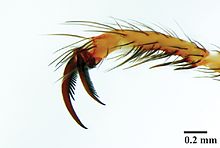Trogloraptor marchingtoni
| Trogloraptor marchingtoni | ||||||||||||
|---|---|---|---|---|---|---|---|---|---|---|---|---|

Trogloraptor marchingtoni , male |
||||||||||||
| Systematics | ||||||||||||
|
||||||||||||
| Scientific name of the family | ||||||||||||
| Trogloraptoridae | ||||||||||||
| Griswold, Audisio & Ledford, 2012 | ||||||||||||
| Scientific name of the genus | ||||||||||||
| Trogloraptor | ||||||||||||
| Griswold, Audisio & Ledford, 2012 | ||||||||||||
| Scientific name of the species | ||||||||||||
| Trogloraptor marchingtoni | ||||||||||||
| Griswold , Audisio & Ledford , 2012 |
Trogloraptor marchingtoni (from ancient Greek τρώγλη trōglē 'cave' and from Latin raptor 'robber') is a spider species from the subordination of real spiders (Araneomorphae). It is the only representative of the genus Trogloraptor and the family Trogloraptoridae so far. The yellow-brown spider lives in an area in western North America, which includes the extreme southwest of Oregon and possibly the extreme northwest of California . It is in the undergrowth of coast redwood - primary forest and in the dark zone of different cave systems to find out where they rudimentary networks builds. Nothing is known about their diet and reproduction. Their claw-like leg extensions, which are unique among all weaving spiders, indicate a predatory way of life.
Species, genus and family were in 2012 by Charles E. Griswold , Tracy Audisio and Joel Ledford , arachnologists at the California Academy of Sciences , first described . The species probably forms the sister taxon to the other taxa in the superfamily Dysderoidea .
description
Male specimens of Trogloraptor marchingtoni reach a prosoma - opisthosoma length of around 9.7 mm, females are slightly smaller at around 9.4 mm. The yellow-brown carapace is pear-shaped and narrowed towards the front. The oval, sparsely bristled abdomen is gray in the male and purple in the female. The pear-shaped bulb of the male is severely swollen and has a curled appendage at its tip. Trogloraptor marchingtoni has six eyes: The anterior median eyes of the species are absent, the posterior median eyes are separate. Trogloraptor marchingtoni has brown jaws . At the ends of the first chelicerae members there are four small and one large tooth. The poison gland opens into a pore at the tip of the second phalanx. The light brown legs are long and slender. The leg formula for Trogloraptor marchingtoni is 1243, which means that the first pair of legs is the longest, the third the shortest. At the end of the fourth leg link (tarsus I) the animals have hook-shaped, flexible claw processes.
distribution and habitat
The spider was discovered in various caves in the Klamath - Siskiyou region in Oregon on the California border. A further distribution is not yet known. A juvenile individual was in coast redwood - primary forests of northwestern California under deadwood found. Since it has a different drawing than the adult Trogloraptor marchingtoni specimens found in caves , it is unclear whether it belongs to this species or to its own species. Despite an intensive search, no specimens could be found under dead wood at the entrance of caves that are inhabited by Trogloraptor marchingtoni .
Way of life
It is known from field observations that the spiders build sparse webs from a few threads and let themselves hang from the cave ceilings under their webs. Laboratory studies on captured specimens to clarify the living conditions failed because the animals refused the food offered and starved to death. Details about the way of life and hunting methods are therefore not yet known.
Taxonomy and systematics
Trogloraptor marchingtoni was first found in 2010 in M2 Cave in Josephine County , Oregon , and additional specimens were collected during the same year and the following year. In 2012, Charles E. Griswold, Tracy Audisio and Joel Ledford described the spider as a new species, genus and family. The authors chose the generic name Trogloraptor based on the cave habitat and the claws of the animals. The specific epithet marchingtoni is dedicated to Neil Marchington, the Deputy Sheriff of Deschutes County . Marchington, who works as a cave biologist in addition to his police office, had given the researchers access to the region's caves and supported them in their field studies.
Comprehensive molecular biological or morphological studies on the systematic position of Trogloraptor within the spider are not yet available. Their simply built, haplogynous genitals (in the female with a single opening for fertilization and oviposition) and the pear-shaped bulb of the male indicate that they belong to the suborder Haplogynae, according to Griswold and colleagues . An analysis based on 16 characteristics showed that Trogloraptor probably forms the sister clade of the families united in the superfamily Dysderoidea . The species is one of a number of relic species from the Pacific Northwest that survived there while disappearing along with the redwood forests in the rest of the continent. If the juvenile Trogloraptor marchingtoni, caught in the Californian redwood undergrowth, were added, the family and genus would be monotypical , otherwise it would belong to a previously undescribed sister species .
Web links
Trogloraptor marchingtoniin the World Spider Catalog
literature
- Charles E. Grisworld, Tracy Audisio, Joel M. Ledford: An Extraordinary New Family of Spiders from Caves in the Pacific Northwest (Araneae, Trogloraptoridae, New Family). In: Zookeys . Volume 215, 2012, pp. 77-102 ( doi : 10.3897 / zookeys.215.3547 ).
Individual evidence
- ^ Wilhelm Gemoll : Greek-German school and hand dictionary . G. Freytag Verlag / Hölder-Pichler-Tempsky, Munich / Vienna 1965.
- ↑ Erich Pertsch: Langenscheidts Large School Dictionary Latin-German . Langenscheidt, Berlin 1978, ISBN 3-468-07201-5 .
- ↑ Griswold et al. 2012, pp. 83-84.
- ↑ a b Griswold et al. 2012, pp. 92-95.
- ↑ Griswold et al. 2012, p. 89.
- ↑ Griswold et al. 2012, pp. 84-86.
- ↑ Griswold et al. 2012, pp. 81-82.

